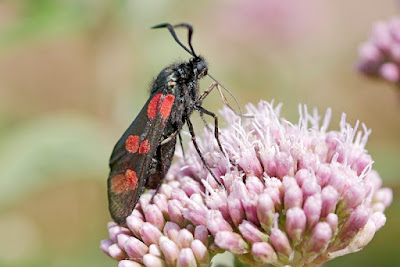July started with a heatwave and it continued for most of the month. However, native plants are quite resilient and many are also drought tolerant. I had a look around a brownfield site near Bodmin and found Common Cudweed, which was responding to the lack of water by simply growing a flowering head and not much else. It's enough to provide seed for next year and thus ensuring the species survival through a difficult time. In better conditions it could be a foot tall with multiple branches each bearing a flowering head.
Filago germanica
Garden Ladies Mantle had also self seeded over part of the site.
Alchemilla mollis
There were at least a dozen Jersey Cudweed plants present too. This species is spreading very fast.
Laphangium luteoalbum
That was it for the brown field site.
One afternoon I had a drive up to Polbrock Bridge where I saw some hefty Thick-lipped Grey Mullet in the River Camel below. These are sea fish that travel right up to freshwater to the limit of the tides to feed on algae and mud.
Chelon labrosus
I took a walk near Tregoss Moor and the road verges were stuffed with Southern Marsh Orchids like this one below. As I write (in August) they are now all gone to seed, so it's nice to remember them here.
Dactylorhiza praetermissa
I don't know if Tutsan plants turn red as they age or if they do so if stressed. This was before the drought kicked in, so it's likely not caused by drought. The red leaves offset by the brilliant yellow flowers was very eye catching though.
Hypericum androsaemum
Bog Pondweed is prolific on Bodmin Moor and all the other moors in Cornwall too. Here it is in flower.
Potamogeton polygonifolius
Flower arranging by nature. A Heath Spotted Orchid with a Bog Asphodel on Tregoss Moor.
Dactylorhiza maculata and Narthecium ossifragum
On some disused ground on a farm track where I parked, were hundreds of Corn Spurrey plants. What made it hard to identify them was that all the flowers were closed when I got there. They only open in the sun. Thankfully, it was sunny by the time I returned to the car and then I recognised them straight away.
Spergula arvensis
The unusual leaf arrangement for this plant.
Below is a typical example of fasciation. This was Hedge Bedstraw near the County Showground.
Galium album
I'd only seen this plant below once before, but it is instantly recognisable as being Balm-leaved Figwort, native to Cornwall, but absent from most other counties.
Scrophularia scorodonia
Growing out of a roundabout on the A39 was a Field Woundwort, a scarce plant and usually an arable one.
Stachys arvensis
On the north Cornwall coastal cliffs, new flowers had emerged, including these Meadow Cranesbills.
Geranium pratense
Some prostrate Dyer's Greenweed was still in flower, though most were now in seed.
Genista tinctoria subsp. littoralis
My part of Cornwall appears to have Greater Burdock as the dominant species, whereas Lesser Burdock is far more common elsewhere. In Greater Burdock, the flowers hardly exceed the exterior bracts and the flowerheads are all grouped at the extremities of the branches. On Lesser, the flowers easily exceed the bracts and the flowers are all over the plant. Here's a bee's eye view of the Greater Burdock flower. Also, the basal leaves are solid in Greater and hollow in Lesser, a useful tip for Winter ID of these plants.
Arctium lappa
Corn Marigold was a bird seed escape in Kent, but here it is still a viable crop plant. Where herbicide use is none or limited it thrives, as here at West Pentire farm near Newquay.
Glebionis segetum
At least a thousand Corn Marigolds flowering on this field edge by the sea.
The fields were very dry, but this didn't bother Bugloss very much. It's quite drought tolerant and flowered quite happily here by the sea. If you look for it, bear in mind that the blue flowers are actually very tiny.
Anchusa arvensis
For some reason Sharp-leaved Fluellen is quite common on the north coastal areas, again, the flowers are very small, but very pretty.
Kickxia elatine
On the cliffs of West Pentire and elsewhere, I found what I thought was Rock Sea-lavender. However, it transpired that these plants were in fact Western Sea-lavender, a South West species of Sea Lavender I hadn't heard of before.
Limonium brittanicum subsp brittanicum
On an evening stroll near Wadebridge (Polmorla), I stumbled upon a purple Meadowsweet. This was of course perplexing as I'd never seen one that wasn't white flowered before. I researched it and found it to be literally called Purple Meadowsweet, a rare garden escape and a first for Cornwall as a whole and possibly all of the UK too. Quite a find and clearly not planted where I found it. As with many plants naturalised, it probably originated from fly tipped material years before.
Filipendula purpurea
Given its scarcity, if you find one in the wild, please let a botanist know, (this is easy to do using social media) to ensure it gets recorded.
Some plants attracted more insect interest than others, and a firm favourite was Hemp Agrimony, here with an attendant 6 Spot Burnet Moth.
Zygaena filipendulae on Eupatorium cannabinum
Drought conditions stressed this Common Field Speedwell resulting in the flower turning a deep blue. This made it look rather like a Grey Field Speedwell which has deep blue flowers but it is smaller than Common Field Speedwells. The best way to tell them apart is by the seeds. In the corner of the photo below are the seeds attached to this plant. They are attached to each other at around 90 degrees, whereas Grey (and Green) Field Speedwells are more or less parallel.
Veronica persica
I hope I never tire of these views, it certainly makes botanising the area even more amazing.
Until next time.
Take care
Dave







































































